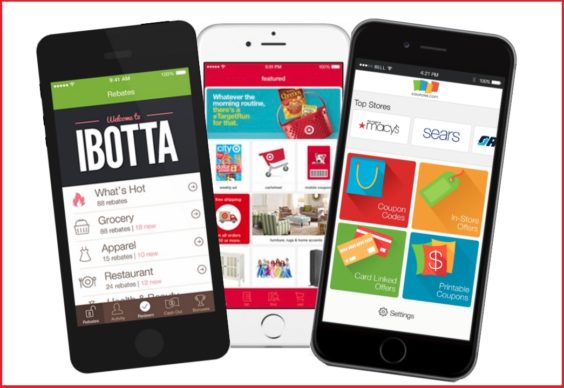
Many mobile savings apps say their discounts are “better than coupons”, and some are even trying to prevent you from stacking their offers with actual coupons. So if you’re faced with a choice between coupons and savings apps, which should you choose?
If you’re looking to maximize your savings, a new report suggests you’re better off ditching the coupons.
That’s according to Kantar Media, which recently provided some insights on coupons and mobile app trends over the past year.
A number of promotion industry groups provide detailed annual analyses of coupon trends – how many coupons are issued and redeemed each year, how much they’re worth, how long they last before they expire, and so on. But as mobile savings apps like Ibotta, Checkout 51 and SavingStar have become more popular, stats about coupons no longer provide a full picture on the impact of promotions and the savings they provide to shoppers.
In its most recent annual Coupon Intelligence Report released last week, Valassis noted that “one of the biggest growth areas in value-seeking methods is mobile savings apps.” Its survey found that 46% of shoppers use cash-back apps, up from 30% in 2016.
But what kind of savings are those shoppers getting? Kantar has stepped in to provide what it says is a first-of-its-kind look at the savings that mobile apps provide, with a peek into what it calls “the most comprehensive coverage of promotion activity on top shopping and rebate apps”.
And its findings show that the savings apps it tracks offer bigger and better savings than coupons do.
Its analysis finds the average face value of mobile offers is $1.98, about the same as paper coupons’ average of $1.99 and far above digital coupons’ average of $1.80. But coupons are notorious for having multiple purchase requirements – “$0.50 off 2”, for example, or “$1 off when you buy 3”. And Kantar says only 1% of mobile app offers require the purchase of multiple items. That makes mobile’s average face value per item much better than coupons.
Still, you have to act fast to take advantage of mobile offers. Kantar says the average offer is available for only 10.8 days, a far shorter period of time than the 5.7 weeks that the average paper coupon is valid, or 4.3 weeks for digital.
So if you want to maximize your savings, should you put away your coupon-clipping scissors and close your digital coupon account in favor of mobile savings apps?
Well, you might want to wait for some more comprehensive data. Because Kantar’s study comes with a whole lot of caveats.
Among the main mobile savings apps it tracks is Target’s Cartwheel, which is a retailer-specific app that doesn’t necessarily reflect the types of offers available on apps that you can use anywhere. Kantar also, confusingly, cites Cellfire, which is really a digital coupon platform and not a savings app at all. And it tracks the empty shell that is MobiSave, which was once a savings app but has now effectively ceased to exist.
So be wary of reaching broad conclusions from some very specific, very limited data.
But considering no one is really tracking savings app offers, Kantar’s effort at least tells part of the story. Traditional coupon use continues to decline, but that doesn’t mean deal-seeking shoppers are just giving up and paying full price. Brands are shifting more of their marketing to mobile, but how do we know how many shoppers are taking them up on their mobile offers, and how much they’re saving in the process?
Cartwheel, Cellfire and MobiSave may not tell the whole story. But compared to no data about savings apps at all – it’s a start.











Target Cartwheel is probably the best app (in my opinion).
First, it started as a regular computer based program, and although it now has an app interface, it can STILL be used directly from a desktop without a mobile phone. Second, its % off offers are on top of store coupons, and manufacturer coupons, and any Ibotta rebates, etc.
Second, it is extremely easy to use, and since it is tied to a specific store you do NOT have to upload receipts (as they are already in the target system).
It is SO different from the other apps like Ibotta and Checkout51 that even including them in the same category is very misleading.
Printed coupons are BETTER than mobile apps in almost every way.
When I use a printed coupon I know IMMEDIATELY if I actually got the discount; when I use an app I may or may not get the discount and only will get the discount LATER, if I get it at all.
With paper coupons I usually can use multiple coupons for multiples of the same item, whereas many/most apps/digital coupons restrict you to a single use.
Many of the more recent apps/digital coupons are starting to be for LESS than the discount on the same item that shows up on printed coupon. This has become very common on digital coupon programs for both Kroger, and to a lesser extent, Safeway.
If there is a problem with a digital coupon/mobile app the store almost always will do NOTHING to resolve the problem, whereas with a printed coupon USUALLY a store manager will fix problem.
The ONLY advantage I see to apps is that they CAN, SOMETIMES require less time to use than paper coupons. But even that advantage goes away when the app just flat refuses to work (like Ibotta has done for me on numerous occasions) and then takes many, many repeat attempts to upload receipts and get them accepted.
So, I’ll keep to my paper coupons, thank you. The apps like Ibotta which occasionally give me an extra discount I will use (but not count on). The apps like Checkout51 where almost all the offers cannot be combined with any paper coupon usage I will just ignore.
coupons yes–apps may restrict you–but coupons are legally available–so visit your Dollar Tree and also some FDS stores also sell papers ($1 ea)-and enjoy–also buy your papers on sunday and get more—Washington Post and Baltimore Sun have coupons in the Saturday editions in their local markets–remember you purchase the newspapers legally and you can use whatever coupons are in them